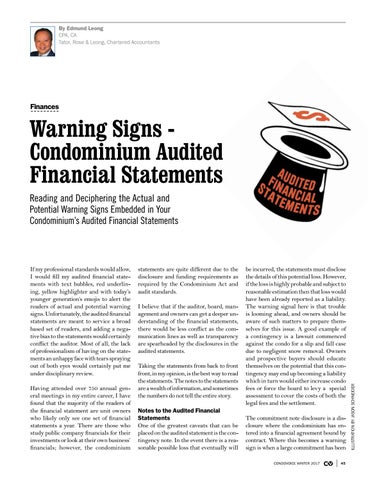By Edmund Leong CPA, CA Tator, Rose & Leong, Chartered Accountants
Finances
Warning Signs Condominium Audited Financial Statements
If my professional standards would allow, I would fill my audited financial statements with text bubbles, red underlining, yellow highlighter and with today’s younger generation’s emojis to alert the readers of actual and potential warning signs. Unfortunately, the audited financial statements are meant to service a broad based set of readers, and adding a negative bias to the statements would certainly conflict the auditor. Most of all, the lack of professionalism of having on the statements an unhappy face with tears spraying out of both eyes would certainly put me under disciplinary review. Having attended over 750 annual general meetings in my entire career, I have found that the majority of the readers of the financial statement are unit owners who likely only see one set of financial statements a year. There are those who study public company financials for their investments or look at their own business’ financials; however, the condominium
statements are quite different due to the disclosure and funding requirements as required by the Condominium Act and audit standards. I believe that if the auditor, board, management and owners can get a deeper understanding of the financial statements, there would be less conflict as the communication lines as well as transparency are spearheaded by the disclosures in the audited statements. Taking the statements from back to front front, in my opinion, is the best way to read the statements. The notes to the statements are a wealth of information, and sometimes the numbers do not tell the entire story. Notes to the Audited Financial Statements One of the greatest caveats that can be placed on the audited statement is the contingency note. In the event there is a reasonable possible loss that eventually will
be incurred, the statements must disclose the details of this potential loss. However, if the loss is highly probable and subject to reasonable estimation then that loss would have been already reported as a liability. The warning signal here is that trouble is looming ahead, and owners should be aware of such matters to prepare themselves for this issue. A good example of a contingency is a lawsuit commenced against the condo for a slip and fall case due to negligent snow removal. Owners and prospective buyers should educate themselves on the potential that this contingency may end up becoming a liability which in turn would either increase condo fees or force the board to levy a special assessment to cover the costs of both the legal fees and the settlement. The commitment note disclosure is a disclosure where the condominium has entered into a financial agreement bound by contract. Where this becomes a warning sign is when a large commitment has been CONDOVOICE WINTER 2017
CV
45
ILLUSTRATION BY JASON SCHNEIDER
Reading and Deciphering the Actual and Potential Warning Signs Embedded in Your Condominium’s Audited Financial Statements
